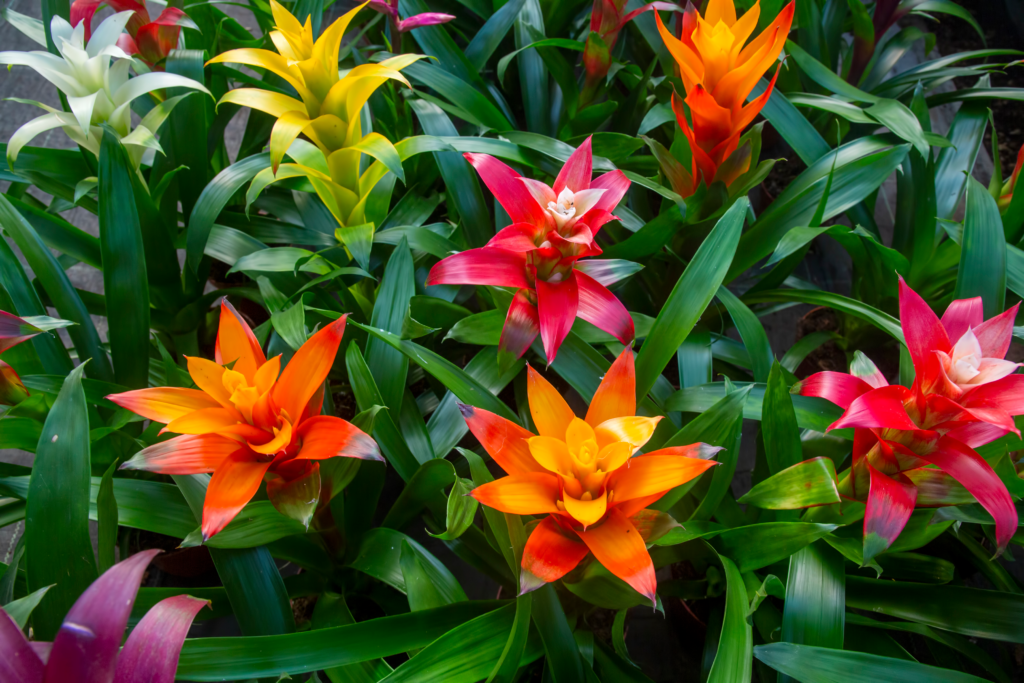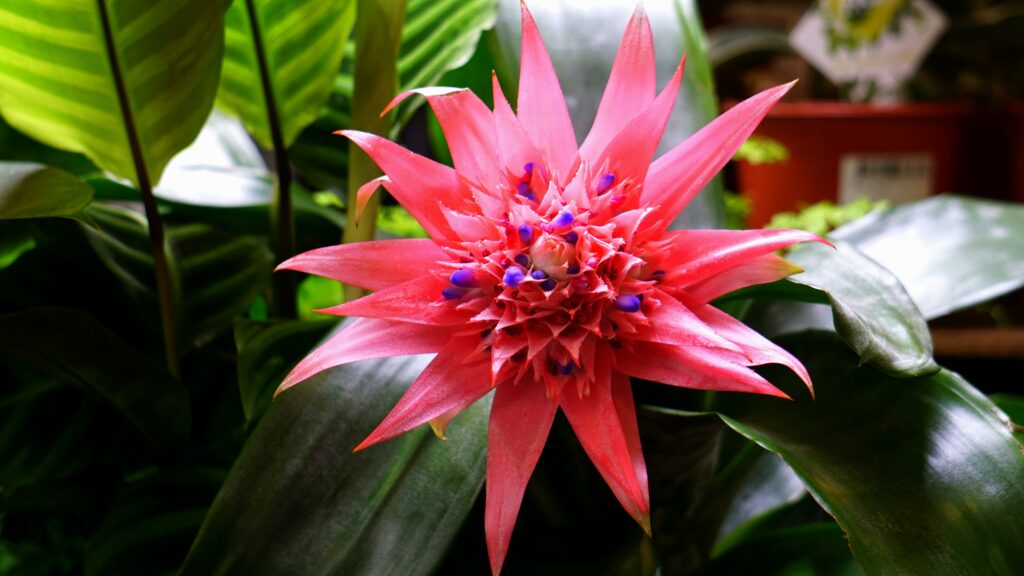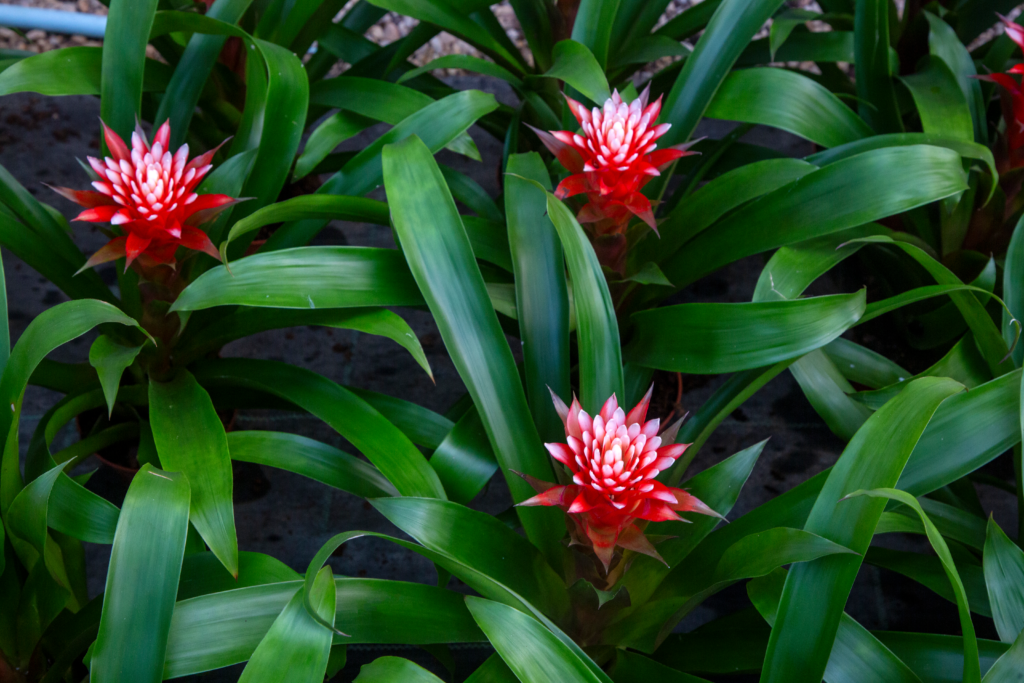
Bromeliads: Exotic-Yet Easy to Grow
With their tropical flair, architectural foliage, and dazzling flowers, Bromeliads are one of the most unique and rewarding plant families you can grow. Whether you’re a seasoned plant enthusiast or just starting out, bromeliads offer color, structure, and a touch of the exotic—without high-maintenance demands.
In this guide, we’ll explore how to grow Bromeliads successfully, what makes them special, and how to keep them thriving year-round.
Origins and Varieties
Bromeliads originate from South and Central America, the Caribbean, and West Africa. They grow in deserts, mountains, and forests. Bromeliads belong to the plant family Bromeliaceae, which includes around 3,500 species, and the most well-known bromeliad is the pineapple. Another popular bromeliad is the tillandsia species, commonly referred to as the air plant. Air plants are epiphytes and don’t require soil. They can be mounted on wood, stones, or hung in decorative containers.
Bromeliads come in a wide variety of shapes, sizes, and colors. Some common varieties include:
Guzmania – known for its brightly colored, funnel-shaped flowers, and rosettes of narrow leaves. These bromeliads make great houseplants.
Aechmea – recognizable by their spiky flower structures and blue or pink bracts.
Neoregelia – has vibrant, rosette-shaped leaves that come in a variety of colors, from greens to reds and purples. Some varieties feature patterned leaves, which make them stand out.
Vriesea – characterized by their sword-shaped leaves and tall, striking flowers. They are often red, yellow, or orange.

Characteristics of Bromeliads
Bromeliads are known for several outstanding traits:
Rosette growth: Their leaves grow in a tight, often symmetrical rosette that can collect water.
Colorful foliage: Many species boast vividly patterned or colored leaves—ranging from deep green to fiery reds and purples.
Striking blooms: Their flowers, although not always long-lasting, are incredibly vibrant and often appear in eye-catching spikes or clusters.
Tank habit: Some species collect water in the central “tank” formed by their leaves—an adaptation from their natural environment.
Epiphytic lifestyle: Many Bromeliads are epiphytes, meaning they grow on trees or rocks rather than in soil, deriving moisture and nutrients from the air and rain.
Care Requirements
Placement: To care for an indoor bromeliad, ensure it receives bright, indirect light, and a humid environment at 50%. A bathroom or a kitchen window can be a great spot. Alternatively, use a humidifier or humidity tray.
Watering: Many bromeliads hold water in the center of the plant. You can keep the center half full of water and flush it out once a month to keep the bacteria from collecting in the water. Be careful not to overwater the soil and let it dry out between waterings.
Temperature: Maintain temperatures between 60°F and 80°F to promote healthy growth. Bromeliads can be grown in pots in cold areas and brought indoors for fall and winter.
Medium: Bromeliads prefer a fast-draining medium to prevent water retention, which can lead to root rot. A mix that allows air to circulate around the roots is ideal. A pre-made orchid mix is a great option because it typically contains bark, perlite, and charcoal, which promotes drainage and aeration. If you prefer to make your own mix, you might consider using pine bark to promote structure and drainage, along with peat moss or coconut coir which will retain some moister without becoming waterlogged. You could also include perlite which will enhance aeration and drainage.
Fertilizer: A diluted liquid fertilizer once a month during the growing season is enough. Avoid over-fertilizing, as it can dull the foliage and harm the plant.

Flowering: Bromeliads usually flower once in their lifetime, but the flowers can last for several months, depending on the species. After flowering, the plant will produce pups, which can be separated and replanted to grow into new plants which will mature and produce their own flowers in one to three years. You can let the bloom fade naturally and cut off the flower spike once it’s spent. The main plant will eventually die, but its offspring can continue to thrive.
Do Bromeliads Like Sun or Shade?
This depends on the species, but most Bromeliads prefer bright, indirect light. Outdoor bromeliads should be placed in a shaded or partially shaded area where they will thrive. Direct sun can scorch their leaves, especially thin-leaved varieties like Guzmania or Vriesea. However, thicker-leaved types like Aechmea or Neoregelia can tolerate (and even thrive in) more direct light.
Indoors, a spot near an east or west-facing window is ideal. You can put your bromeliad outside during the summer, provided the temperature remains warm and it’s not exposed to direct, harsh sunlight for long periods.
How Long Do Potted Bromeliads Last?
The lifespan of a Bromeliad varies by species, but in general:
- The parent plant lives for about 2 to 5 years, depending on care.
- Each plant blooms only once, but the flowering can last from a few weeks to several months.
- After blooming, the plant will eventually die, but not before producing “pups”, or offsets, that you can repot and grow into new plants.
So, while the individual plant may be temporary, its legacy continues through its offspring.

What Do You Do With a Bromeliad After It Blooms?
After blooming:
- Enjoy the flower as long as it lasts—some species retain their color for months.
- Once it fades, don’t discard the plant—it will start producing pups at the base.
- Wait until the pups are about 1/3 to 1/2 the size of the parent plant, then gently remove and pot them separately.
- Continue caring for the parent plant until it dies naturally—it may produce multiple pups during this time.
This cycle is part of what makes Bromeliads such rewarding houseplants.
How Many Times a Year Do Bromeliads Bloom?
Bromeliads bloom only once in their lifetime, but the bloom can last a long time—weeks to months depending on the species. After blooming, the plant focuses its energy on producing pups rather than blooming again.
That said, with proper care and pup propagation, you can enjoy continuous blooms from new plants throughout the year if you stagger them well.
Bromeliad Displays
Bromeliads can be displayed in a many attractive ways, depending on the variety you have. They look fantastic on windowsills, tables, or shelves, especially in areas with bright, indirect light. To create a striking display, group different varieties with contrasting colors and shapes. Some bromeliads, like Tillandsia species, can be suspended in air, making them perfect for hanging baskets or mounts. Small bromeliads fit beautifully in terrariums and can add a touch of tropical elegance to your living space. For outdoor spaces, consider growing bromeliads in hanging baskets, along garden beds, or even in a decorative pot on a patio or balcony.

Final Thoughts
Bromeliads are not only beautiful but also relatively low-maintenance, making them an excellent choice for both beginners and experienced gardeners alike. By providing the right care, you can enjoy their stunning colors and unique shapes for months, and even years, to come. Whether you display them indoors or outdoors, these fascinating plants will add a tropical touch to your home or garden.

Hello,
I found your article on bromeliads very informative. Could you provide details on the light requirements for different species, specifically comparing Guzmania and Tillandsia? What practices should I follow for indoor care?
Additionally, what are the best fertilization methods for promoting healthy growth and blooms in bromeliads? Are there specific fertilizers or schedules that work best?
Thank you for your help.
Kevin, thank you for your comments and questions about bromeliads. They are such wonderful plants, with so many varieties. As far as light requirements, all the varieties need bright indirect sunlight. For fertilization requirements, I am glad you mentioned Guzmania and Tillandsia because with so many different varieties, it is not a good idea to give a one fits all fertilization schedule. In fact, most varieties don’t require fertilizer to thrive. However, certain ones can benefit from light fertilization, especially for flower production. In the case of Guzmania, you can use a low nitrogen liquid fertilizer at 1/4 strength or pellet sprinkled lightly around the top of the soil. For Tillandsia, you can purchase a once monthly low nitrogen spray specifically for air plants. It will help with plant growth and production of blooms and pups or offshoots which is how they produce new plants.